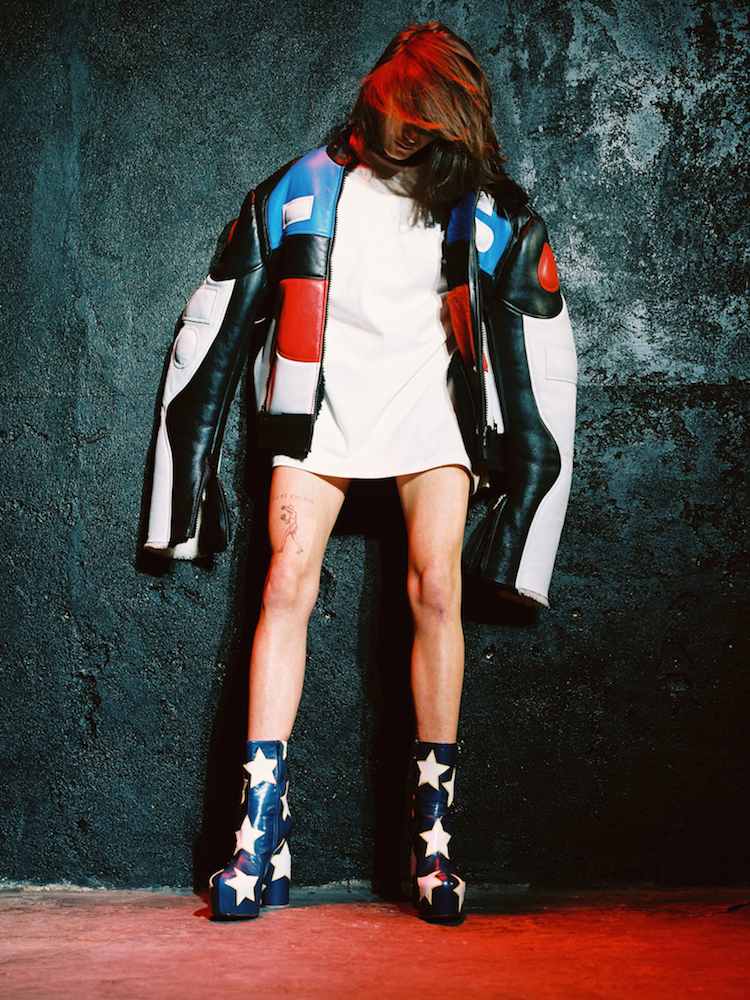There’s something happening in Paris right now. It may not be burning exactly, but you can feel the heat of a new kind of creative energy. It was there when Simon Jacquemus sent a shirtless model down his fall/winter 15 runway (followed by a ripple of whispers). And it filled the seedy depths of Le Depot, Paris’ famous sex club, when Vetements held its fall presentation there last month.
Vetements — a loosely anonymous fashion collective made up of eight former members of major design houses and led by Margiela alum Demna Gvasalia — seems to have plugged straight into some lost creative power source. In just three seasons, its gritty, disruptive approach has created a buzz that few other young Parisian brands have come close to in recent years. Its clothes, like floor-grazing flight jackets, diced-up T-shirts, and floral prairie dresses worn, unnervingly, with leather gloves, feel rebellious and just a little wrong.
We caught up with head designer Demna Gvasalia to talk about Vetements and Paris’ next generation.
In a recent interview you said that “there is no youth culture in France.” Why do you think that is?
There is a lack of evident and defined youth culture at present, possibly due to the overwhelming amount of information available through the internet and the fact that mass media and social networks are so commercialized. Also France has been quite culturally conservative lately.

Are things beginning to change?
We hope so. It feels like more and more people are daring to disagree with established views about society and fashion. There’s a turn towards the personal and individual as a response to globalized thinking. We’re not really trying to change anything with Vetements. We simply try to reflect what we feel is going on around us today in Paris and its suburbs.
What’s Paris nightlife like right now, and is that something that informs Vetements?
Nightlife is always very inspirational. It’s where we see the reality of youth and where people dare to be themselves without boundaries. Paris nightlife is pretty dead; it turned itself into a parody of fun. That’s why we staged the show at Le Depot, because it’s authentic, rough and real, and it’s not trying to be anything that it’s not.
Three of the eight LVMH Prize finalists, including Vetements, are French. How is the fashion scene in Paris evolving?
Nothing really happened in Paris until Jacquemus [launched], a few of years ago. Now, it feels like new brands are emerging. But there still aren’t as many as there are in the UK. Being supported in London is easier I think — there are institutions like the British Fashion Council. In Paris, it’s very limited. But there is a certain energy in the air, a vibe. There’s a new generation of people, these kids in their 20s, who want to do things differently, who aren’t conservative or trying to mimic their parents’ ideas about what is Parisian or what is right or wrong. It’s been stagnant here for a while; we needed this fresh energy. And now it’s here and it’s exciting.

Why is this happening right now?
I don’t know. It used to be that you couldn’t even go out in Paris. There were no concerts. The cool bands wouldn’t stop there. And even that’s changing now. I guess it’s also the influence of social media and information. These people who are 22 years old, they live on their iPhones. It’s a different time completely, things are pushing forward. It’s less about sitting in a cafe on the Rive Gauche now. We don’t know that part of Paris.
Who are the other members of Vetements? And have they stayed anonymous intentionally?
We started out being anonymous out of necessity, because we had other jobs. But it played out well because none of us wanted publicity. Also, I used to work at Margiela, as did some of the other guys, and we wanted tolose that association — anonymity is a concept Margiela has already worked, as more of a PR stunt. For us though anonymity was an obligation; so now we don’t want to push the it further. But we still don’t like to be photographed. We don’t even take selfies!
How did Vetements begin?
During lunch breaks at our “other” jobs, in the evenings and at weekends, drinking white wine, smoking and talking.
And how do you all work together?
We are eight people in total, a few on design, some on production and some on sales and administration. I am in charge of the design team. We discuss everything together, brainstorm, argue and find solutions. It’s really democratic.
What excites you most about being involved in fashion today?
It’s exciting to see women want and wear our clothes, that’s the biggest motivation and compliment. I think it’s also exciting to be involved in fashion now because it’s a period of transition and change. The challenges and dilemmas that arise are pretty awesome.

Credits
Text Alice Newell-Hanson
Photography Harley Weir
